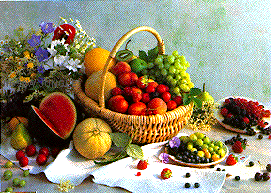

The Index
Click
Here
ABSOLUTELY FREE
XXX PICS!
History
Medical Products
Taste
Smell
Touch
Sight
Sound
The Mind and Body as an Aphrodisiac
Contact Us
Want to find out more?
Check Out the Aphrodisiac Qualities of the "Sex Positions Guide" CLICK HERE NOW
All About Aphrodisiac Foods To Stimulate Your Six Senses
Love potions have been described since the fourth century B.C. Today there are thousands of foods thought to have aphrodisiac properties.
I followed the bubble trail out to the garage, where water from the garden hose was running into a wheelbarrow. My nephew Jeff was squeezing a whole bottle of dishwashing liquid into the wheelbarrow while yelling to my 5-year-old nephew, "Keep stirring, John!"
We're making a "magic potion", explained Jeff. "Where did you find this magic potion recipe?" I asked. "Oh, there's no recipe", said Jeff. "We just read about magic potions and decided to try and make one".
With spring approaching, my thoughts naturally turn to love and romance. So, I decided to follow Jeff's lead and concoct my own magic potion. An edible one, of course. As background material, I polled my colleagues at work to find what their "magic potions" might be. "Anything chocolate", most people said. One connoisseur said, "Oysters, lobster, and alcohol". "Any foods I don't have to cook myself", said one frazzled working mom. A few of the more unusual responses from the group included "Stew, because it's messy and you can really get your hands messy"; "black olives because my Eastern European grandfather told me that would make me passionate"; and "a healthy meal makes me feel good about myself and therefore, passionate". My favorite response? "Any food can be your magic potion....if you believe it."
Theophrastus (4th century B.C.), a Greek botanist, recommended a love potion that included a leafy plant called mandrake soaked in vinegar. Supposedly mandrake contains substances that create the sensation of "feeling high". According to ancient Indian recipes, love can be enhanced with a mixture of black pepper, honey, chili peppers, and mandrake. Apicius, who lived during the reign of Julius Caesar and authored the first known cookbook, suggests a stew of onions, pine kernels, and various herbs as an effective love potion. Perhaps my colleague who recommended stew as an aphrodisiac had done some research on her own!
Today there are thousands of foods presumed to have aphrodisiac properties. These include (raw) seafood, chocolate, wine, spices, and even sugar. An Italian psychiatrist, Willy Pasini, has actually researched foods that supposedly have romantic properties. Dr. Pasini discovered during animal experiments that maize, a type of corn, contains a compound called "tryptophan". He believes that tryptophan combines with other chemicals in the brain to act as an aphrodisiac. Maize is a component of polenta, a trendy carbohydrate dish served in most restaurants as a potato alternative. However, "polenta causes gas", warns Dr. Pasini, so we may never be able to eat enough to experience the aphrodisiac effect.
To intensify passion, Dr. Passini also recommends that you add sparkling wine, fruit, and chocolate to your meals. Apparently, however, Dr. Passini is not the first to promote fruit as an aphrodisiac. Apricots and peaches are considered erotic symbols by the Chinese. Ancient Greeks celebrated each new crop of figs, while ancient Jews considered fruit an important part of the mating ritual.
The aphrodisiac powers of food have also been perpetuated in film. Perhaps you saw the movie "Like Water for Chocolate?" The female lead roasted, cooked, and baked all sorts of divine goodies in preparation for various life events. The elaborate food preparation and subsequent consumption transformed a simple family dinner into a sensual mating ritual. The food orgy scene in "Tom Jones" left many breathing heavily. And perhaps one of the most classic lines in modern film history was uttered in "When Harry Met Sally". Upon watching Meg Ryan seethe and froth in an (imaginary) orgasmic frenzy after eating, the older woman sitting next to her announces that "I'll have what she's having..."
As early as the 13th century, cookbooks discussed the pleasures of food. An abundance of food was considered a sign of affluence and pleasure. Europeans would never think of celebrating without a feast. A wedding feast, for example, might begin with meat cooked in sugars and spices. A variety of meats and cheeses would be served next, accompanied by curds and followed by desserts. Fruit and wine completed part I of the wedding feast. The guests would return the second day for lasagna, cheese, meat, spices, and more fruit. Author Massimo Montanari describes these thirteenth century food orgies as a "sin of gluttony and the new indulgences dreamed up by the insane passions of man".
An article appearing recently in the Dallas Morning News cited some modern aphrodisiacs. An anthropology student interviewed a number of fellow students who apparently believe that green (and only green) M&Ms are the new passion food. While querying the sisters at one Texas university sorority house, the interviewer found a large candy jar filled with green M&Ms. When questioned further, the sorority sisters admitted that they only serve the candy at "special times".
Maybe it's not the green coloring. According to Debra Waterhouse, Registered Dietitian and author of Why Women Need Chocolate, "chocolate is a pleasure food". Waterhouse explains that when we eat chocolate, certain brain chemicals flood the brain that make us feel happy. When Waterhouse interviewed women to describe how they felt about chocolate, some said that chocolate was "pure ecstasy". Unfortunately, I have yet to sample enough chocolate to create the aforementioned ecstasy. I will keep trying. I fear, however, that my eventual ecstasy will be tempered by my frustration as I begin to outgrow my favorite secret lingerie. It's spring. I'm in love. I want to create a potion that is sensuous and inviting; sweet and creamy with a velvet-like texture. So I've decided to cook up a potion created by Apicius in the first century A.D., aptly named "Roman Custard".
This site is for you enjoyment, education and entertainment. About Aphrodisiacs takes no responsibility for the efficacy or use of the claims and products suggested here. About Aphrodisiacs can be contacted through John Ryan,Wellington, New Zealand or email john@aboutaphrodisiacs.org. © Aboutaphrodisiacs 2001.

